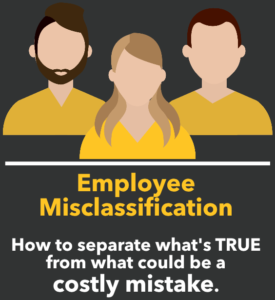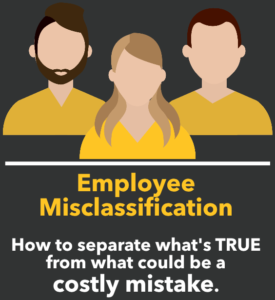The IRS and U.S Department of Labor (DOL) are more vigilant than ever before about enforcing proper employee classification. That means, as an event or entertainment business employing a contingent or freelance workforce, it’s absolutely critical for you to correctly categorize your crew members as either independent contractors (1099s) or part-time employees (W-2s) in order to adhere to regulatory guidelines and avoid employee misclassification penalties.
According to the DOL, “misclassification” refers to a worker who is an employee under the law, but the individual is inaccurately classified as something other than an employee. In the past, little attention was paid to the employee classification – companies could decide to classify their crew based on whatever was best for their business and/or what their crew members wanted to be. However, as the contingent workforce grew and as freelancers have become a larger part of the overall workforce, regulations and governmental scrutiny has increased substantially.
Since 2008, the DOL has employed thousands of additional investigators who are tasked to “detect and deter” companies from misclassifying employees as independent contractors. At the same time, many states have entered into a memorandum of understanding (MOU) with the DOL under the “Misclassification Initiative” to share and coordinate their enforcement efforts.
Event and entertainment businesses are now highly focused on figuring out what proper employee classification means to them and what is most beneficial to both the organization and its crew members. Nowadays, more and more companies are hiring W-2 crews in order to avoid hefty employee misclassification concerns.
What are the penalties for misclassifying your workforce? All it takes is one worker to file a complaint with either the state labor agency or federal DOL to receive hefty fines. In the case of unintentional employee misclassification, you could incur the following penalties:
- $50 for the W-2 form that was not filed due to improper classification
- 1.5% of the wages (since income tax was not withheld), plus 40% of the social security and medicare (FICA) taxes the employee should have paid and 100% of the matching taxes the employer should have paid
- A “failure to pay taxes” penalty of 0.5% of the unpaid tax liability for each month, up to 25% of the total tax liability
And this is for just 1 case. Multiply this by an entire workforce that is improperly classified, and it becomes clear that these employee misclassification penalties could easily shut down a business. If the IRS suspects fraud or intentional misconduct, you could be looking at substantial additional fees including as much as 20% of the worker’s wages and 100% of the FICA taxes. Worse, there is the possibility of criminal penalties and imprisonment that could accompany this as well.
Obviously, it’s never been more important to get employee classification right. For a refresher about what is TRUE about employee misclassification and what could be a very very costly mistake, check out our new infographic:



